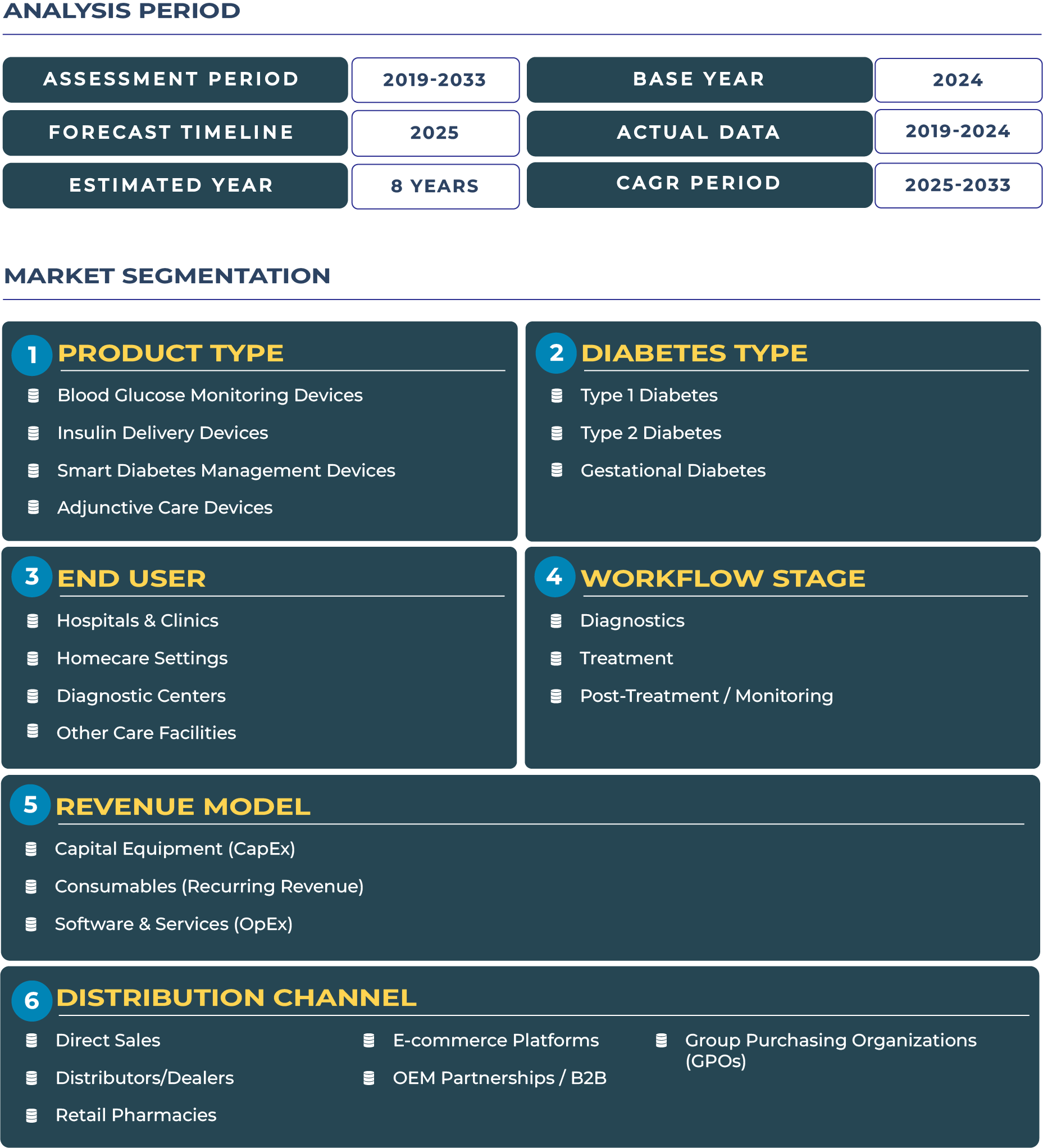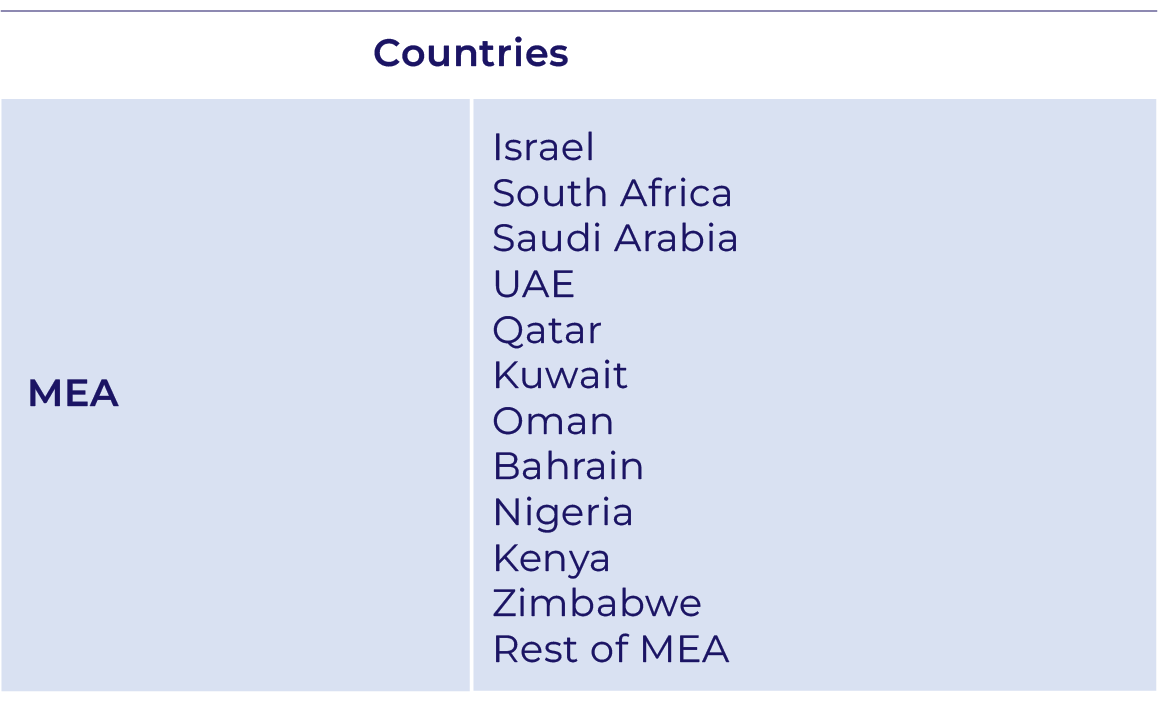Report Format:
![]()
![]() |
Pages: 160+
|
Pages: 160+
MEA Diabetes Care Devices Market Outlook: Balancing Premium GCC Models with Scalable African Solutions
The Middle East and Africa (MEA) diabetes care devices market is evolving under a distinctive two-track approach. This model balances premium bundling strategies in high-income Gulf Cooperation Council (GCC) markets with scalable, low-cost distribution frameworks across Africa. Such a strategy addresses the region’s inherent heterogeneity—where GCC countries emphasize advanced, technology-driven diabetes management solutions, while Sub-Saharan Africa (SSA) prioritizes affordability and accessibility. In 2025, the market is valued at USD 716.6 million and is projected to reach USD 1,081.3 million by 2033, growing at a CAGR of 5.3%. This performance is underpinned by rising diabetes prevalence, government-led public health initiatives, and expanding access to insulin delivery devices and continuous glucose monitoring (CGM) solutions. The interplay of premium healthcare investments in the GCC and cost-optimized innovations for African nations underlines the rationale for this dual strategy.
How a Two-Track GCC + Africa Strategy is Shaping MEA diabetes care devices Industry
The outlook for the MEA diabetes care devices sector highlights a bifurcated strategy that is uniquely tailored to regional contrasts. In the GCC, healthcare systems benefit from robust infrastructure, state-of-the-art hospitals, and insurance-backed patient access, enabling higher uptake of smart diabetes management devices and advanced insulin pumps. Meanwhile, in Africa, demand is shaped by affordability, local distribution networks, and government or NGO support programs. This dual dynamic is projected to accelerate market growth between 2025 and 2033, ensuring resilience despite macroeconomic pressures such as inflation, supply chain disruptions, and geopolitical instability. Rising urbanization in African cities, coupled with increasing government allocations to healthcare budgets, creates fertile ground for adjunctive diabetes devices such as lancets and test strips, particularly where affordability is crucial. As a result, stakeholders investing in this market must adopt both premiumization in GCC countries and scalable volume-driven approaches in Africa to ensure sustainable expansion.
Drivers & Restraints: Navigating Growth and Constraints in the MEA Diabetes Care Devices Ecosystem
Premium GCC Pockets Driving Technology-First Adoption
The GCC has emerged as a stronghold for premium diabetes care solutions. Strong purchasing power, favorable reimbursement structures, and high prevalence of diabetes (especially Type 2) are driving the adoption of advanced insulin delivery devices, smart diabetes monitoring apps, and CGMs. Saudi Arabia, the UAE, and Qatar, for instance, are advancing pilot programs integrating AI-enabled monitoring into public hospitals. This rapid adoption supports market growth, enabling manufacturers to capitalize on innovation-led demand.
Affordability and Procurement Complexities Hindering Africa’s Growth
In contrast, SSA faces affordability challenges and fragmented procurement channels. With healthcare budgets constrained, reliance on NGO-driven device access programs remains high. Moreover, inconsistent regulatory pathways across countries such as Nigeria and Zimbabwe delay product approvals, discouraging new entrants. These constraints dampen the pace of adoption for insulin pumps and advanced smart devices, while lower-cost solutions like SMBG kits dominate. Procurement complexity, limited reimbursement frameworks, and infrastructure gaps collectively slow market penetration, especially in rural areas.
Trends & Opportunities: Unlocking Digital Health Pilots and NGO Partnerships Across MEA
Digital Health Pilots Leading to Regional Innovation
The GCC has become a testbed for digital health pilots, integrating CGM devices with telehealth platforms to enhance patient monitoring. For instance, in 2024, several UAE hospitals expanded remote diabetes monitoring programs leveraging mobile health technologies. These pilots are influencing wider adoption across African urban centers such as Nairobi and Lagos, where digital penetration is rising. As health systems embrace digital integration, CGMs and insulin delivery devices become increasingly mainstream.
NGO and Government Programs Expanding Market Access
NGOs and government programs are pivotal in bridging the affordability gap. For example, initiatives in South Africa and Kenya, supported by organizations such as the World Health Organization, aim to expand affordable access to blood glucose monitoring devices. These partnerships not only improve healthcare equity but also enable manufacturers to penetrate underserved markets. The expansion of procurement partnerships and government tenders presents opportunities for growth in test strips, lancets, and cost-efficient insulin pens.
Regional Analysis by Country
Saudi Arabia
The Saudi Arabia diabetes care devices market benefits from Vision 2030’s healthcare transformation agenda, driving investments in CGM and insulin pump solutions, with strong adoption across public hospitals.
Kuwait
Kuwait shows rising adoption of blood glucose monitoring devices, supported by public insurance schemes, though challenges remain in integrating advanced insulin delivery technologies.
UAE
The UAE market thrives on private-public partnerships and high-tech device rollouts, with smart diabetes management tools gaining rapid traction in urban centers like Dubai and Abu Dhabi.
Oman
Oman’s focus on strengthening primary healthcare networks enhances access to SMBG kits, while advanced insulin pumps see selective uptake in tertiary care facilities.
Bahrain
Bahrain emphasizes early diagnosis and management through subsidized SMBG devices, while digital health integration in diabetes management is gradually expanding.
Qatar
Qatar is prioritizing diabetes management through hospital-led device adoption programs, ensuring early penetration of CGMs and smart management solutions.
South Africa
South Africa faces affordability challenges, yet rising partnerships with NGOs and government programs drive access to glucose meters and insulin pens in urban and peri-urban markets.
Israel
Israel stands out as an innovation hub, with strong adoption of digital diabetes monitoring solutions and export-led device manufacturing feeding regional markets.
Nigeria
Nigeria’s growing diabetes population fuels demand for cost-effective monitoring kits, though fragmented procurement slows penetration of insulin delivery devices.
Kenya
Kenya is benefiting from increasing urban hospital networks, where SMBG and insulin pens are widely distributed, supported by donor-funded health programs.
Zimbabwe
Zimbabwe diabetes care devices sector remains constrained by economic challenges, with market access heavily reliant on NGO and multilateral aid programs.
Competitive Landscape: Strategic Dual Models and Market Expansion
The MEA diabetes care devices landscape features a mix of multinational and regional players. Companies such as Dexcom and Medtronic dominate CGM and insulin delivery markets, while regional distributors play key roles in SMBG access. In October 2023, Dexcom announced the rollout of Dexcom ONE+ across European and MEA markets, signaling a regional expansion of CGM technologies. This strategy reflects the two-track model: GCC markets serve as premium hubs for advanced technology launches, while Africa is approached with volume-driven, affordable products. Regional manufacturers are increasingly collaborating with governments to secure tenders, ensuring alignment with local needs. This dual framework safeguards margins in GCC markets while unlocking scalable opportunities in Africa.








